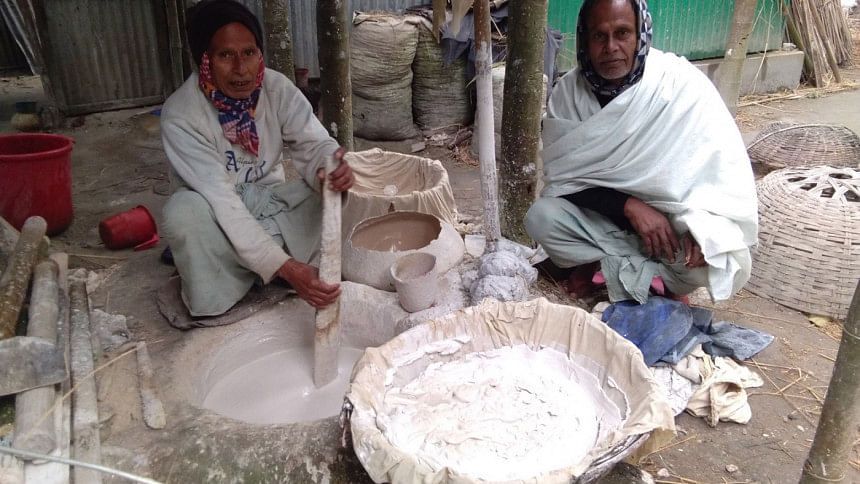Kolichun faces threat of extinction

Producers of kolichun, slaked lime made from oyster shells, are leaving their traditional profession due to low demand of their product and high cost of production materials.
Locally known as jugee, makers of this particular type of slaked lime blamed oyster scarcity, competition from industrially produced calcium hydroxide, and low demand for betel leaves and nuts eaten with slaked lime for the loss in their business.
The Devnath community belonging to the Hindu faith in Kurigram have been involved in the hereditary profession of making kolichun (slaked lime) from oysters for centuries.
Jugee Sachindra Nath Devnath of Chandijan village of Pandul union under Ulipur upazila said they have to buy oysters from shell collectors. Beforehand, these freshwater molluscs were available in abundance for free in rivers, canals and other waterbodies.

Once collected, the oysters are boiled to help open the shells and extract the body. The shells are then piled for a couple of days to dry off, then burned in an earthen kiln. Water is added to the ashes of the burnt shell to make slaked lime or calcium hydroxide, Sachindra explained.
Besides, the cost of shells, jugees also need firewood, jute stick and straw required to burn the shells, said the 80-year-old.
He informed that one maund (40 kg) of shells costing Tk 300 is needed to produce one mound of slaked lime. With fuel and labour to fan the kiln, Tk 600 is spend for making one maund of slaked lime.
Jugee Kalipado Devnath of the same village claimed, slaked lime is sold for Tk 30 per kg and jugees make about Tk 1,200 per week by selling the product in the local haat (village market).
“Thirty years ago, I could feed my family with the money I earned from selling kolichun because I could collect oysters for free from rivers. Now I have to buy oysters and straws and it becomes impossible to run my family with the meagre profit,” he said.
Unable to run his family with such low income, Kalipodo now works as a day-labourer, while keeping his ancestral occupation as a part-time affair.
Jugee Suzan Chandra Devnath, 20, of Kathalbari union in Sadar upazila, is getting even less selling a maund of slaked lime.
“We could sell 40 kilogram of slaked lime every haat-day six months ago, but now we can sell around 20 kg and the rate per kg has come down from Tk 30 to Tk 20,” he claimed.
The jugees noted that the number of people consuming betel leaf and nut with slaked lime has also not increased, rather in Suzan’s opinion the number is decreasing.
Besides, the kolichun produced from oysters have a darker shade compared to the industrially produced calcium hydroxide forcing jugees to keep their price lower in fear of losing out to competition.
According to jugee Sachindra, kolichun is also used in some herbal, traditional medicine and sometimes used in fish ponds as a disinfectant but that practice has become obsolete too.
Urging the government to take initiatives to save the age-old profession, the jugees of Kurigram asserted that improved technology for the burning process could bring their cost down and help them compete with the industrially produced slaked lime.
Director of Bangladesh Bhawaiya Academy Bhupati Bhusan Barma believe that slaked lime production from oyster shells could be considered as a small cottage industry.
He said, loans with easy condition can be provided to the jugees to save the industry and research on the benefits of such naturally produced lime should be undertaken.
Meanwhile, District Fisheries Officer Kalipada Roy blamed encroachment of waterbodies and water pollution as the reason behind the oyster scarcity.
Reduced water flow from encroachment of rivers and canals, unplanned use of pesticides, and waste disposal in waterbodies has created an adverse environment for oyster breeding, he added.

 For all latest news, follow The Daily Star's Google News channel.
For all latest news, follow The Daily Star's Google News channel. 



Comments